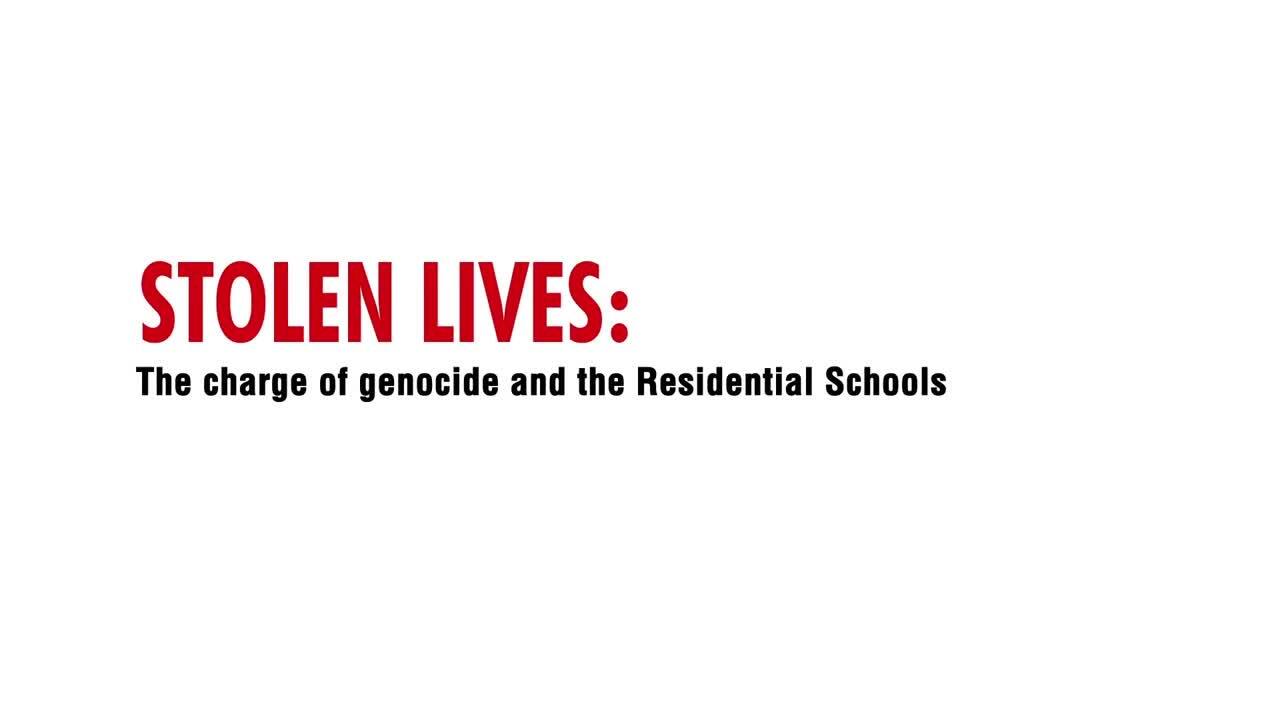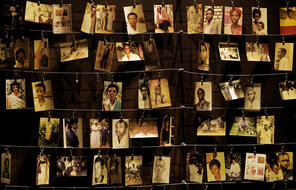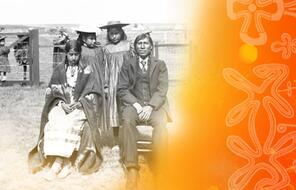Breadcrumb
Stolen Lives: The Charge of Genocide and the Residential Schools
At a Glance
Language
English — CASubject
- Social Studies
- Genocide
Stolen Lives: The Charge of Genocide and the Residential Schools

[NON-ENGLISH SPEECH]
[NON-ENGLISH SPEECH] is how we say, our nation, my name is Tae ho węhs, my true name and my spiritual name. And it translates as "he works with words." When I was given that name, it was done through ceremony, and it was sent up to the Creator through music and speech.
After the American Revolution, the Haudenosaunee Confederacy were allies to the crown, the Dominion, against the American colonies.
We came here to Grand River as a result of being on the losing side, and we got this treaty-- I call it a treaty also called the Haldimand Deed-- of six miles on each side of the Grand River, and it tore apart the Haudenosaunee Confederacy. We initially were set up by our nations under this civilization-- not a culture, a civilization-- with languages and ceremony and ritual and an economy, and we already had a political democracy.
So that's what I bring in when the TRC came out with "cultural genocide," I asked myself and I asked my colleagues and I say it now, why do we need an adjective in front of genocide? They outlawed our languages. They outlawed our music, our dance, and our fundamental human rights to organize and worship with a different theology and spirituality. So what do you have left, right?
We need to understand that particular Convention as, if you like, a kind of boardroom compromise. It's not something that was generated with a clear and collective sense of what the law needed to be. By the time the Convention is ratified and it becomes part of the United Nations governance structures, what we find is that it's been shorn of anything that might indict these very powerful nations with the charge of genocide.
There was a section devoted to the topic of cultural genocide, and that was Article III in the 1948 version of the Convention before it went to the General Assembly and then was excised. And a couple of countries that were very prominent in removing it were, of course, Canada and the United States. But many European nations and others were concerned about this because they saw sovereign nations having a right to assimilate what they would perceive as subject peoples, peoples who were considered to be, in their language of the time, primitive or backward.
And the result is that it's not particularly good law to use when applied to certain kinds of cases of historical violence, particularly colonial violence. Why? Partly because they have a long duration, right? And it's very difficult to think about the intent that the Genocide Convention talks about that can be sustained so clearly over 100, 150, 200 years. It's just difficult to think of it in those terms. And it leaves out and fails to recognize the genocidal aspects or character of the experiences suffered by many people who've had to live under colonialism.
So built into the Genocide Convention around this notion of cultural genocide is already a colonial mentality for understanding which groups are worthy of protection and which groups aren't.
I think if you look at the term "cultural genocide" and how it's in context with the term "genocide" or "settler colonial genocide" or "colonial genocide," of course, cultural genocide limits how we think of the term and how we consider the history of residential schools. A lot of focus focuses on section II (e), the transfer of children from one group to another, and I think that's an important distinction to make. A lot of legal scholars and a lot of political science scholars and people who look at the Genocide Convention from a legal perspective really focus in on II (e), as they should.
I try to look at the term "cultural genocide" from an indigenous perspective, but also from a broader perspective. In the way that Lemkin wrote the Genocide Convention and the way that cultural genocide fits into that bigger term is looking at, from an indigenous perspective, that physical, mental, spiritual, cultural, emotional parts of our life are inseparable.
And to separate culture from physical or biological or mental or emotional or spiritual, it's not possible to fragment one part of a person's identity or a person's life. So I hesitate to only use the term "cultural genocide" to understand residential schools as a total system, as a way of forcibly removing language and culture, and forcibly separating indigenous children from their families for generations.
Because when you forcibly remove children from their homes, you're interrupting family, and family is the bedrock of community. So you take away the kids, you sever the ability of parents to acculturate their children, bring them into a way of being in the world.
And once you've done that and you alienate those children further from their culture by relocating them to either schools that teach them contempt for their culture or other families that are non-indigenous families, for example, that have no way of teaching these children how to be indigenous, then what happens to indigeneity? What happens to the particular communities that these children are from when they go back to these communities? Can they contribute to the maintenance and ongoingness of these communities? Well, of course not.
When survivors talk about having all of their hair cut off, all of their clothing and belongings burned as soon as they entered the residential school, their names were taken away, they were given numbers, they were often loaded onto the back of an army truck or empty train car, and as they're talking about that imagery and as they're thinking of a vocabulary to describe to me what that was like, the term comes up over and over again.
So the use of the cultural genocide terminology in the TRC report is interesting for that reason because of this history and the ways in which indigenous peoples and their concerns factored into the reasons why it was removed. I also think them using the cultural genocide language opens space for people like myself, for indigenous scholars, for survivors, to have a deeper conversation about genocide in Canada.
So I think we have to work on educating people about thinking about genocide more broadly, more generously, and more inclusively as a process of primarily group destruction. When the TRC released its report, what they were doing was trying to sort of, again, highlight those particular costs to indigenous people of settler colonialism. But in doing so, if you like, they coined a term, cultural genocide, as though it were a distinct category. And again, for scholars like myself, it's not a distinct category at all. It's genocide, simply.
When something's genocidal, it means that the fundamental integrity of a group has been systematically assaulted in a way that makes the group no longer possible to persist. You can starve of a group of any number of resources that that group needs to maintain itself. These can be resources that have as a consequence the physical emaciation and destruction of the members of the group, but you can also starve resources from the group that allow it to perpetuate itself culturally, right?
And what is culture? Culture is a sort of mechanism of exchange through which we come to understand ourselves as implicated in a kind of belonging that's about more than just us, a collective belonging. And when, again, the kind of connections between people are severed and can't be renewed, then that group will start to atomize, fall apart.
In the Canadian colonial context, that was cast as assimilation and presented as a good. That was supposed to be a good thing to do. Nobody ever really looked at what it might mean for members of a group to be forced to somehow reaffiliate, to find some other way of finding purchase on languages, practices, identities, that weren't indigenous to them. It's not a different outcome. The outcome is the same. It's just the means of prosecuting the genocide are different.
Stolen Lives: The Charge of Genocide and the Residential Schools
You might also be interested in…
Language and Identity

Membership

The Indian Act and the Indian Residential Schools

The Residential School Experience

Apologies

Truth and Reconciliation

History in Search of a Name

Civic Choices

Langue et identité

Teaching Holocaust and Human Behaviour (UK)

Genocide Still Happens

Historical Background





